How to Start a Glamping Business in 2025: The Essential Guide for Vacation Rental Operators
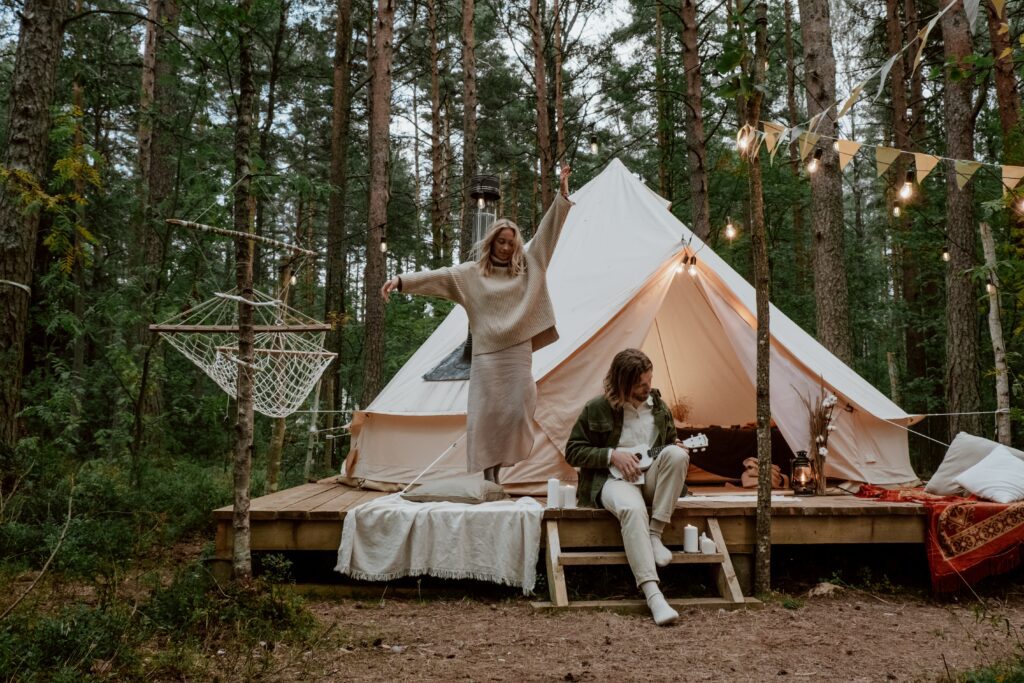
While launching a glamping business certainly has its rewards, like quick ROI and large scaling potential, it also comes with implicit risks.
There are safety hazards, weather complications, zoning laws, and planning issues, like sanitary facilities and in-unit electricity, to get ahead of.
Use this in-depth guide to get started planning your glamping business and smoothly transition into this increasingly popular niche in the tourism industry.
Market trends in the glamping business today
Glamping is more popular now than it has ever been. Grand View Research reports that in 2021, the global glamping market came in at a value of $2.35 billion. It is expected to more than double, reaching $5.94 billion, by 2030.
That same year, the U.S. glamping market size was valued at $463.7 million, and it has a projected CAGR of 13.9% over the next decade or so. With these promising growth projections, now is the time to enter the glamping market.
According to the 2019 North American Glamping Report published by Kampgrounds of America (KOA), millennials are the driving force behind the glamping industry, making up almost half the travelers who’d participated in glamping in the two years prior to being surveyed.
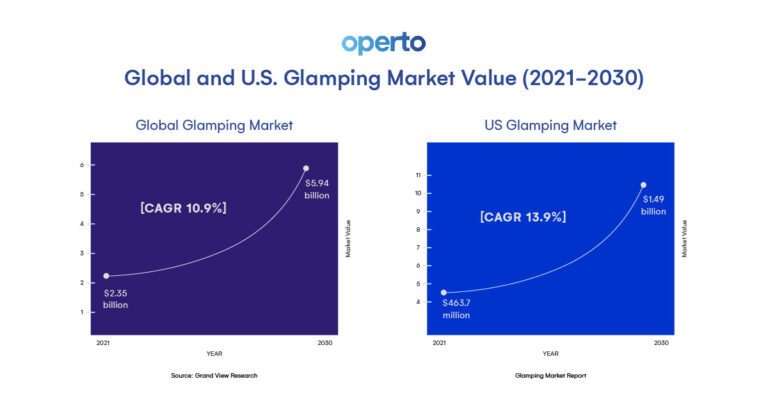
How to start a glamping business: Key steps
To make your life easier when starting your glamping business, follow these six steps:
1. Research potential locations: Location is perhaps the most important consideration to keep in mind when starting a glamping business. Where you build your business determines what type of glamping accommodations you can build, how many months of the year you will be getting active bookings, and what types of amenities you can offer to your guests.
2. Choose a glamping business model: Which glamping model is right for you depends on your location, as well as your initial investment capabilities. Cold and rainy regions aren’t an ideal setting for tent glampsites, but if your funds are limited, building a cabin may be too pricey. Fortunately, there are plenty of glamping models to fit every location and budget.
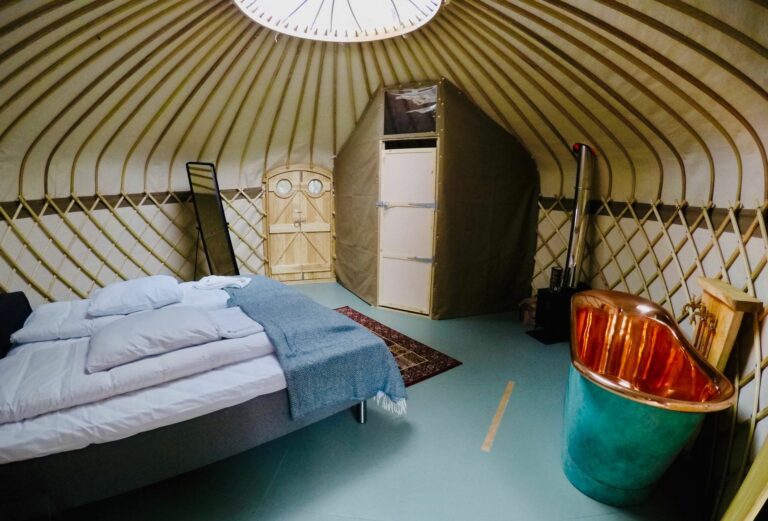
3. Understand location zoning laws: You must attain planning permission before you lay any of the groundwork for your glamping business, so one of your first steps should be to get all of the permits and licenses you need for your specific type of glampsite. And keep in mind that these permits vary between types of glampsites, as your county may not classify a tent or dome in the same way they would a cabin.
4. Plan funding and make sure your budget is feasible: Are you paying for your glamping business out of pocket? Do you need to get funding? Before purchasing or building your glampsites, make sure you’ll have your finances in order. Fortunately, there are plenty of ways to finance your business, like small business loans, and even platforms like StartEngine. Plus, if your start-up costs are low, as they tend to be with glamping models like tents and pods, you can even finance your business purely with savings.
5. Build a brand and promote it: Creating a brand identity and promoting it will be key to the success of your business. Glamping is all about the experience, so market your brand and its unique selling proposition (USP) on multiple channels. This means creating your own website and harnessing the power of social media.
6. Consider ways to automate your operations: One of the best ways to make your glamping business profitable in the long run is by automating and streamlining your processes. Consider tools like Operto’s keyless access capabilities and curated digital guidebooks to improve your guests’ stays while simplifying your business operations.
What glamping business models are there?
Glamping goes beyond your standard tents and cabins. There are countless types of glamping sites out there, but here are some of the most popular:
- Tents: Tents probably come to mind when you think of traditional camping. However, glamping tents cover a wide range of accommodations, including safari tents, the typical bell tent, and A-Frame tents.
- Yurts: While some classify yurts within the same category as tents, these are actually traditional Mongolian dwellings that tend to be much more spacious than tents. Yurts are circular structures built with a wooden frame and a sturdy canvas covering.
- Pods: Pods (also referred to as domes) are an incredibly sought-after glamping experience. Many glamping pods are essentially dome-shaped wooden structures, though they can also be constructed with plexiglass to create a sense of exposure to the elements, as well as other materials.
- Cabins: As you probably know, cabins are also wooden structures, usually larger than pods, which may or may not be equipped with electricity/running water.
- Treehouses: Treehouses are an increasingly popular type of glamping destination. One glamping company builds networks of treehouses in a unique glamping business model.
- Tiny homes: While they come at a higher initial investment, tiny homes offer an escape from urban life while still providing basic conveniences like water, electricity, heating, and cooling. Tiny homes range from 60 to 400 square feet.
- Camper Vans/RVs: Believe it or not, you can find camper vans and RVs on booking sites like Airbnb. This type of glamping model is especially adaptable, as they can be moved to various locations and equipped with remote keyless access.
Creating your glamping business plan
You’ll need to create a glamping business plan when deciding how to design your glamping business. Here are a few key elements that you need to focus on.
Pinpoint your target market
If it’s your first time creating a glamping business, you need to start by identifying your target market. Do some research on the type of people who frequent the glampsites in your area so you know what kind of guest you should design your business for.
Are most guests young couples with children? Single millennials? Retirees? Having your target market clear will allow you to curate the guest experience specifically toward that audience and make your glamping business’s USP stand out.
Identify possible locations
Location is key when it comes to building a glamping business. The first thing to keep in mind when choosing a location seems pretty basic, but it is often overlooked: Weather. If you want to build your business in an area with inclement weather conditions, you need to consider whether it’s worth it if you’ll only be operable a quarter of the year.
Also be sure to take a close look at zoning restrictions and the permissions you’ll need to build a glampsite. Depending on the glamping model you choose (tents vs cabins, for example), zoning laws may or may not allow you to put your business into action.
Research potential competitors
Once you have an idea of who your glamping business will be for and where you’ll build it, it’s time to examine the competition. A lot of competition in your area will mean that you need to create an exceptionally distinctive USP.
But on the other end of the spectrum, Wil Slickers, Founder of HFM, co-founder of Recreation Vacation Rentals, and host of Slick Talk: The Hospitality Podcast, points out that: “Few competitors in your area could mean one of two things. Either there is an untapped market that you are about to make the most of, or there are complications for creating a glamping business in your desired location that you aren’t yet aware of.”
Dive deep into competitor research, combing sites like Airbnb, Glamping Hub, Hipcamp, and Booking.com. You can search for things like booking frequency, what extra amenities and unique experiences potential competitors offer, and average rates.
Create a budget and financial plan
Because the cost of starting a glamping business can vary so widely, closely calculating your estimated costs and return on investment (ROI) is essential to the success of your glamping business. For this, you should consider how your initial building and start-up costs will impact your ROI.
For example, if you’re building a tent glamping business, your low initial investment can result in faster ROI, even in the first year of business. But consider whether you’ll be profitable year-round or if you will have to close during the colder months, as well as the fact that you can’t charge as much for a tent glampsite as you would for an accommodation equipped with more amenities, like a tiny home.
When done the right way, glamping businesses can be very profitable. On the high end of the market, you have glamping domes that bring in over $1,000 in a weekend and treehouses for almost double that price. But you’ll also find yurts that charge around $100 per night, and tiny homes with nightly rates under $150.
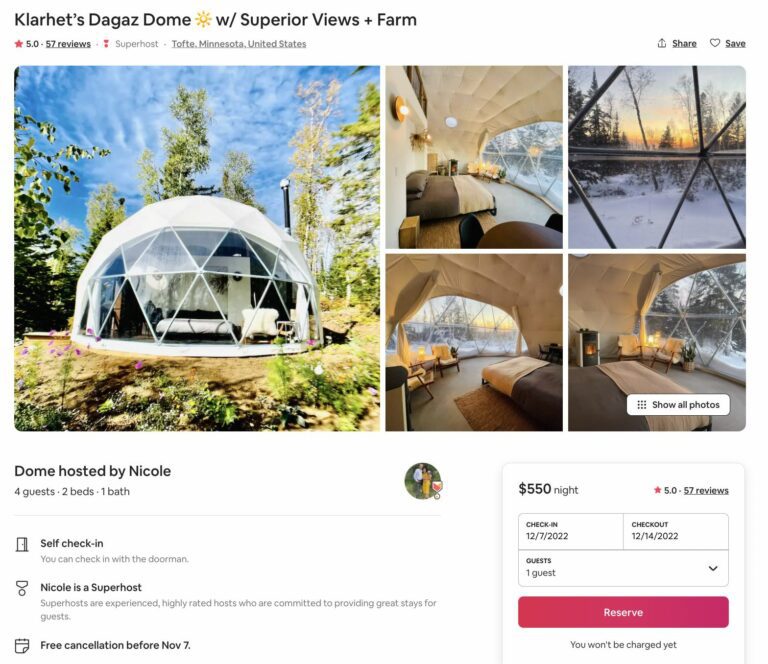
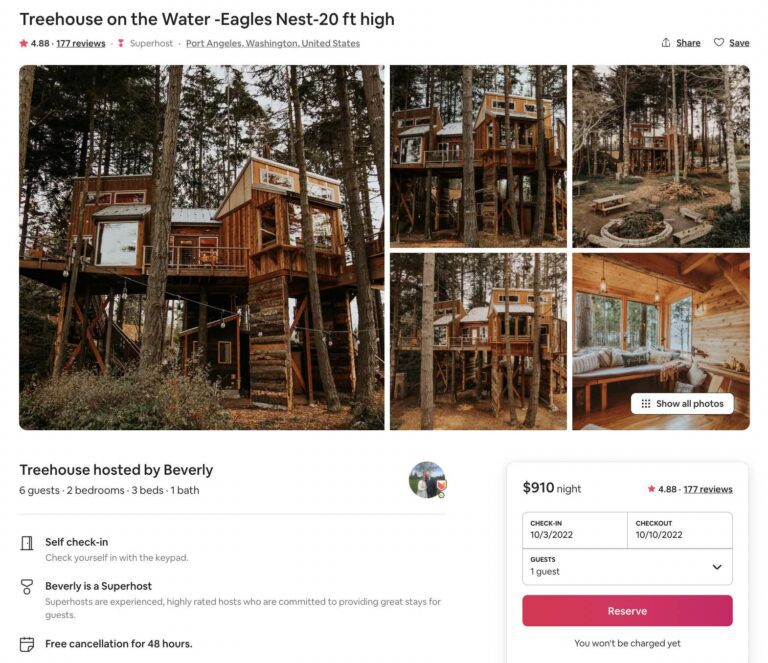
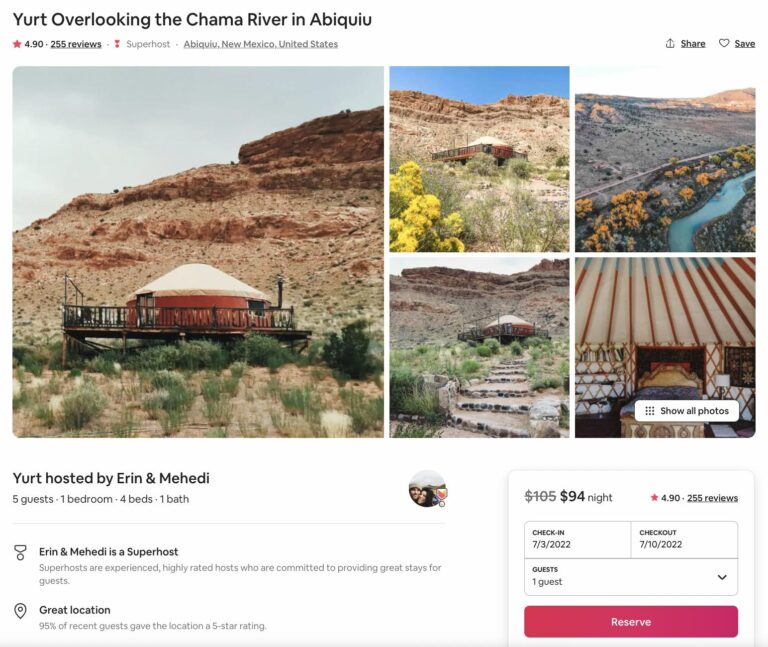
Make sure your glamping business plan will work by creating a realistic budget and estimating your ROI while keeping all related expenses (both planned and unexpected) in mind.
Structure your business operations
Efficient day-to-day operations are essential to any successful business, so see where you can automate tasks and communications or introduce smart tech.
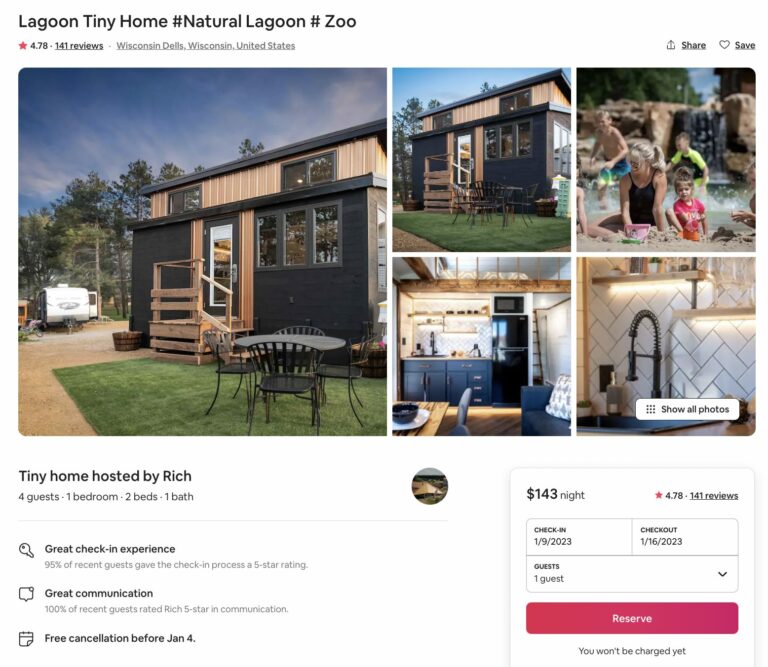
You may already be familiar with keyless entry for rental properties—could smart locks and other tech solutions work for your glampsite? Also, research guest communication solutions like Operto Guest for direct messaging, guides, and in-app upsells.
However, it’s crucial here to consider the potential limitations of your glampsite. Keyless entry, for example, requires the property to have a strike plate, which could work for a tiny home but not for a tent. If you don’t have access to electricity or WiFi, you may be restricted as to what types of tools you can use, so keep that in mind when planning your location and type of accommodation.

What to research when starting a glamping business?
Without the right research, any new business is unlikely to succeed. Dive deep into the following areas before committing to laying the groundwork for your glamping business.
Weather
We’ve said it before, and we’ll say it again: Weather is a huge factor when it comes to the success of a glamping business. If you want to offer accommodations in the Pacific Northwest, you need to be prepared for rain damage and off-seasons. And if you want to build a glampsite in Vermont, be sure it can hold up to the snow. Remember: The harsher the weather, the higher the maintenance costs, as you’ll probably need extra onsite storage for linens and have to repair any storm damage when particularly severe conditions strike.
Land permissions
Once you’ve decided where to build, it’s time to research zoning laws. Each plot of land has different building restrictions and guidelines, so do your research and contact a local authority, like your local planning and building department, to get a clear understanding of what type of glampsite you can legally build at your desired location.
Safety logistics
Are you building a treehouse on a raised structure? You need to make sure you also build proper safety rails. Are you building a firepit on site? Be sure there’s a source of running water nearby. Research all of the safety logistics of your glamping business before undergoing any building.
Operations tools
How can you optimize your business operations? Look into tech solutions that could create a more seamless workflow for you and your staff and a more enjoyable experience for your guests. This could include digital house manuals like the ones you can create with Operto Guest, which allows you to enhance the guest experience by giving them tips on how to pack, information about what to expect when they arrive, and insider insights into the local area.
Glamping guests
When researching your target audience, pay attention to what type of vacation your potential guests are seeking. Are they searching for a remote getaway where they can escape the stress of everyday life? Perhaps they’re just looking for a cool camping experience with added amenities.
Or do they desire community and the opportunity to meet other like-minded travelers? When surveyed, 63% of glamping guests stated they want access to social activities during their glamping vacation. Get to know your guests, and plan your glamping business accordingly.
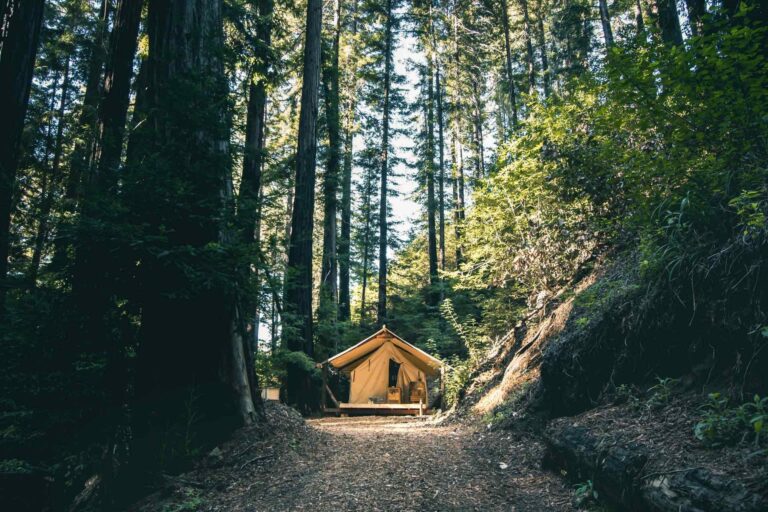
Is your profile of glamping guest looking for a communal experience or a solo retreat? Be aware of this when planning your glamping business.
Housekeeping and maintenance solutions
Housekeeping and maintenance can be just as complicated with glamping properties as with traditional vacation rentals, especially when it comes to turnovers. So while a vacation rental home has a linen closet where you can store fresh sheets and towels, for a glamping property you might need vacuum-sealed linens under the bed for cleaners.
Do your research into making the turnover process as smooth as possible. You should also look into scheduling software like Operto Teams to keep track of housekeeping and maintenance tasks across all your properties. This will become even more important as your business and team grow alongside the need for better coordination and communication.
Extra amenities
Research what you can do to set your glamping business apart from the rest. Will Stewart, co-founder of glamping supply company Cedar Spring Recreation, advises anyone who is starting a glamping business to “out-amenity your competition”. Hot tubs and saunas, for example, are obvious winners with guests.
But if large installations are out of your realm of possibilities, get creative. You can offer your visitors the opportunity to buy firewood and s’mores supplies on-site, or sell fresh-baked bread and farm-raised eggs from local suppliers in the morning. These little details go a long way in designing a curated glamping guest experience.
Marketing and promoting a glamping business
You know what type of glampsite to build, and how and where you’re going to build it. Now it’s time to construct one of the most important facets of any glamping business: your brand. According to KOA, 56% of glamping travelers want to stay in unique accommodations, so when it comes to glamping businesses, having a selling proposition that is truly unique is key.
From all his years in the hospitality industry, Wil Slickers shares a key piece of wisdom: “Glamping guests are looking for an experience, not an accommodation. Your brand should be built on both your lovely glamping facilities as well as the incredible surroundings, outdoor activities, and unique attractions in the area.“
And while you can definitely list your glampsites on booking engines like Airbnb and Glamping Hub, a glamping business should always have its own website. This is where you can highlight what makes your glampsites special and share your personal story.
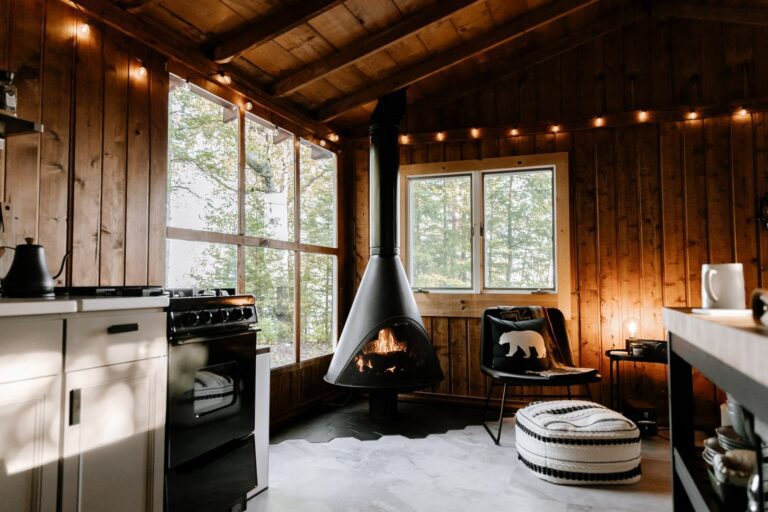
Finally, use social media to your advantage. Considering that 60% of all glamping travelers are either Millennials or Gen Zers, take advantage of these free marketing platforms to carefully craft your brand identity. For example, you can use Instagram posts to promote your accommodations and stories to market the experiences that guests have access to when staying with you.
Starting your very own glamping business: Key takeaways
While there are many steps that go into starting a glamping business, there are some key points you can focus on to help make sure it goes smoothly.
For example, you need to create a viable business plan, do in-depth research, and get to know your guests before you go about constructing any tent or cabin.
Also, be sure to look for ways to optimize your business, like smart guest software and extra amenities that will keep guests coming back year after year. The glamping market is getting more and more competitive, which is why setting your business apart from the rest with extras like curated guidebooks and smart tech can give you a key advantage.
Finally, be sure to promote your glamping business, sharing information both about the accommodations and the special experiences it provides. Showing is always better than telling, so you may want to consider investing in professional photography services to showcase how special your glamping experience can be.
At the end of the day, the most important thing to keep in mind is to build a brand that makes your offering truly unique. Remember, glamping guests seek a more holistic experience, one that allows them to connect with nature and disconnect from daily stressors, so your glamping business should deliver just that.
Frequently asked questions
Often defined as “luxury camping”, glamping offers guests an eco-friendly experience while still having access to the creature comforts that they expect while vacationing. Glamping experiences often provide extra amenities and resort-like services while still allowing guests to be immersed in nature.
A glamping business has a relatively low initial investment cost (compared to a traditional vacation rental home) while offering quick ROI. Having a glamping business is great for entrepreneurs who want to dive into a niche market on the rise and are passionate about creating unique experiences for their customers.
Glamping pods, or domes, can start at around $4,000 to build and can run up to more than double that. But remember, that’s just the purchase and construction of the pod itself, which will have to be furnished and maintained.
Considering the relatively low initial investment cost of glamping pods, they can absolutely be a lucrative model for your glamping business. You can find some glamping pods with rates of over $1,400 per night.
Ready to see Operto in action?
See why thousands of hospitality businesses trust our solutions to deliver exceptional guest experiences.
Latest News
Stay informed and inspired: discover the freshest blog articles, latest updates, and breaking news.


